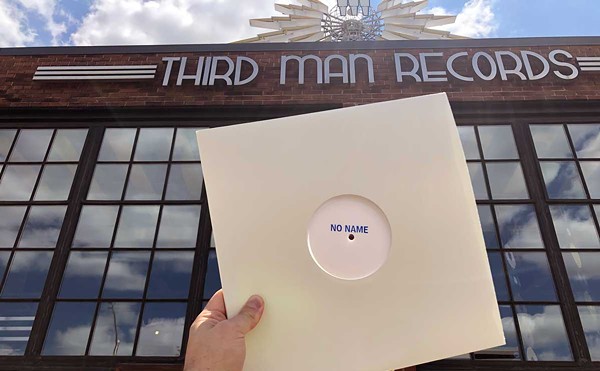Almost 40 years have passed, and the average rock ’n’ roll fan still doesn’t hear the Detroit Wheels singing “see Mitch Ryder” instead of “CC Rider” on the second verse of “Jenny Take a Ride.” Similarly, your average fan let a lifetime go by without appreciating what heavy hits Ryder laid on them. And what Ryder Americans could still be enjoying if they hadn’t let their subscriptions lapse after his last stateside release, the 1983 John Cougar Mellencamp produced Never Kick A Sleeping Dog.
In Europe, Ryder has maintained a continuum of a career since the late ’70s. There he (with guitarist Robert Gillespie) can perform a two-hour show and demonstrate the range of his gifts in front of large appreciative crowds, performing songs from his import-only albums with intriguing titles such as A Dark Caucasian Blue, Smart Ass or The Old Man Springs a Boner. An upcoming German live DVD Mitch Ryder and Engerling featuring Robert Gillespie (of two concerts at the Rock Palace filmed more than 20 years apart) is evidence that his vocal range has expanded beyond the glorious shrieks of yore.
The Hamtramck-born Ryder began his artistic rebirth with the darkly autobiographical How I Spent My Vacation in 1978 when he brought the house down at San Francisco’s Old Waldorf Theatre by doing his own music for the first time. Ryder calls the show “the biggest monkey off my back that I’d ever experienced. I had to live in the shadow of a manufactured star as opposed to someone who had the right to be one.”
If Ryder’s livelihood and reputation in this country rests squarely on re-creating a half dozen hits at oldies shows with a pickup band, so be it. Even taken alone, his Detroit Wheels bestsellers are enough to qualify him for major-league status; after all, his influence has extended to Ted Nugent, Bruce Springsteen, Alice Cooper, Iggy and the Stooges and the MC5. That the aforementioned Detroit rock names are all Hall of Fame shutouts (and that Kiss is guilty by association for merely singing “Detroit Rock City”) is an argument for another day. But why the fools in New York don’t let the fools in Cleveland induct Mitch Ryder and the Detroit Wheels into the Rock and Roll Hall of Fame remains a dank and deeply disturbing mystery. But it’s not one that causes Ryder any sleepless nights. He knows exactly why.
“There’s six members on the board of directors and three of those men are my enemies. So what are my chances of getting in there?” he asks. “I came out of Detroit with a sense of self and when I came to New York, that’s what they tried to destroy. And not being highly educated, I reverted to street tactics and that included calling some very rich and powerful people terrible names in the press.”
Ryder’s strong sense of self goes back to the early ’60s when he held his own singing in a black vocal group called the Peps and later secured a storied regular gig at the Walled Lake Casino as Billy Lee and the Rivieras, an earlier incarnation of the Wheels.
“I did stage dives, that started at the Walled Lake Casino,” explains Ryder. “Except back then nobody caught you. They’d just make room for you on the floor. We had such a great stage show and became so huge that the Motown artists had to come out there and open for us. And that was without the benefit of a record.”
Ryder’s eventual success opened up the Detroit market for white rock ’n’ rollers and put his hometown on the map in a way that eager-to-please Hitsville U.S.A. never could. “I was the only alternative to Motown,” he agrees. “I auditioned for them but I didn’t have enough original material. They were looking for another Smokey Robinson.”
Two years later, after Ryder had three Top Ten hits and Hasbro had even created a palm-sized “Show Biz Babies” doll in his likeness, Berry Gordy asked Ryder to become a Motown artist. “Thanks, but I already made it, pal,” Mitch informed the man who wrote “Money.”
Upon seeing Billy Lee & the Rivieras open up for, and bury, The Dave Clark Five, Four Seasons’ producer Bob Crewe signed them up to his custom label Dyno-Voice Records. He originally marketed Mitch Ryder as a solo artist for his first single called “I Need Help,” but equal billing could not be denied to his backup band next time around, sounding as they did like the most perilous amusement park ride you’d ever want to experience. It was the positive reaction in the control room from the visiting Rolling Stones that convinced Crewe to release “Jenny Take a Ride” — originally slated for the B-side — as the next single. But the Rivieras handle would have to be changed, in case the Rivieras (of “California Sun” fame) ever rose from the dead and felt litigant. As 1965 turned the corner, the newly christened Mitch Ryder and The Detroit Wheels (originally bassist Earl Elliot, drummer Johnny “Bee” Badanjek and guitarists Joseph Cubert and James McCarty) became the first self-contained rock group to reach No. 1 on the R&B charts, beating blue-eyed soulsters the Young Rascals by several months.
With this successful party record formula in place, Crewe translated the group’s live sound to vinyl and exhausted the band’s repertoire of covers by shoving them into medleys that proved irresistible for most of 1966 and 1967. When Springsteen’s E Street Band needed a show closer to bring down the house, Mitch’s medleys were their source material. The Wheels’ “Devil With A Blue Dress On” medley was remarkable: Drummer Badanjek’s bass-drum foot pounds the pocket like a supercharged Rolex then “Good Golly Miss Molly” can make him rest; guitarist Jim McCarty’s trills could rival an ambulance for urgency.
And then there’s “Sock It To Me Baby,” possibly the most insane party record ever minted, plastered with nervous maniacal laughter and Ryder slurring potentially offensive S&M lyrics to make them sound even dirtier. There’s a contingent of people who will never hear “honey in the beehive” as anything but Ryder asking “want it in the behind?”
Ryder credits the energy of these sides to band members’ natural exuberance channeled by Crewe’s manic presence in the studio.
“He was everywhere shouting and screaming. It was like going to a carnival in Rio … it was unreal,” laughs Ryder. “You won’t hear that stuff on Four Seasons records.”
Most people blame Crewe for forcing Ryder to make the love-it-or-hate-it What Now My Love, a concept album of sorts, if that’s what you want to call Ryder singing ballads without the Detroit Wheels. Says Ryder, “Crewe saw a weakness in the group and he exploited that. Jim McCarty was the purist of the group. He wanted to keep it basic, two guitars, bass, drums. I wanted to, not destroy the Wheels, but add instruments, more specifically horns.”
They formed a compromise for some records including “Sock It to Me,” where horns chaotically coexist with psychedelic guitar solos. Once the group imploded, the Detroit Wheels pursued psychedelic music for one hard-to-find single before calling it quits.
“It was called ‘Linda Sue Dickson,’ which, of course, the initials spell LSD,” chuckles Ryder. “I thought that was kinda cool.”
Scott Morgan of ’60s blue-eyed soul punks the Rationals, whose current band Powertrane (with longtime Ryder guitar hero Robert Gillespie) occasionally plays the singer up these days, recalls, “I don’t know what part Mitch had in this, but he got rid of the Wheels, got this big orchestra, put together this Vegas show and overextended himself. He got into debt and didn’t sell any records with the new direction. Then he split, came back to Detroit two years later and formed Detroit, but only Johnny B. was in that band.”
By then Jim McCarty had joined the Electric Flag and later Cactus, and then the Rockets. The R&B-tinted Detroit also featured Steve Hunter, whom Lou Reed would later pinch because he liked Detroit’s version of “Rock and Roll” better than his own. That band lasted for only one album with Ryder, who went on hiatus.
“Hiatus? I ran for my life,” he laughs. “There was a cultural lifestyle in the group that no one could survive. High 24 hours a day, violent, angry. It burned me out. I went to Colorado to see if there was anything worth pursuing. There was a lot of damage.”
It’s all fodder for Ryder’s memoirs, which he spent two years compiling and which may have found a home with a Canadian publisher. Limited space here prevents us from including tales of his wilderness years of working manual labor while nursing his muse, or his brief attempt at becoming an actor with the William Morris Agency, or being set up on a publicity date with Liza Minnelli.
“Hollywood, that’s where I could’ve gone if I wasn’t such a punk. If I just learned to bend over and say thank you a little more politely, it could’ve been great,” he says.
With 24 albums to his credit, Ryder’s not about to stop now. “My belief is that whether I ever find fame again or not is irrelevant,” he says. “My duty to myself as an artist is to document my progress. I do that on a yearly basis. But at the end, whether anybody’s heard them or not, there’s the proof that I was not idle.” He plans to complete another new CD this year, and follow it with a huge European tour that includes England. Eight countries, 33 one-nighters in 39 days — even a 21-year-old might balk at such a punishing schedule. But the man whose youthful, acid-chewing mug circa 1971 was recently featured on the cover of a German magazine with the legend “the Gargantuan volcano” knows how to pace himself on the road.
“These days, my idea of a party,” he says, “is fresh linen.”
This story is the 12th part of our Century of Sound series, tracing Detroit’s musical heritage over the last hundred years.
The next local Mitch Ryder show is on Friday, Oct. 8, at the New Dodge (8850 Joseph Campau, Hamtramck). Call 313-874-5963 for info.
Serene Dominic is a freelance writer about music. Send comments to [email protected]




